A perspective: engineering periosteum for structural bone graft healing
- PMID: 18509709
- PMCID: PMC2584255
- DOI: 10.1007/s11999-008-0312-6
A perspective: engineering periosteum for structural bone graft healing
Abstract
Autograft is superior to both allograft and synthetic bone graft in repair of large structural bone defect largely due to the presence of multipotent mesenchymal stem cells in periosteum. Recent studies have provided further evidence that activation, expansion and differentiation of the donor periosteal progenitor cells are essential for the initiation of osteogenesis and angiogenesis of donor bone graft healing. The formation of donor cell-derived periosteal callus enables efficient host-dependent graft repair and remodeling at the later stage of healing. Removal of periosteum from bone autograft markedly impairs healing whereas engraftment of multipotent mesenchymal stem cells on bone allograft improves healing and graft incorporation. These studies provide rationale for fabrication of a biomimetic periosteum substitute that could fit bone of any size and shape for enhanced allograft healing and repair. The success of such an approach will depend on further understanding of the molecular signals that control inflammation, cellular recruitment as well as mesenchymal stem cell differentiation and expansion during the early phase of the repair process. It will also depend on multidisciplinary collaborations between biologists, material scientists and bioengineers to address issues of material selection and modification, biological and biomechanical parameters for functional evaluation of bone allograft healing.
Figures

References
-
- {'text': '', 'ref_index': 1, 'ids': [{'type': 'PubMed', 'value': '17707711', 'is_inner': True, 'url': 'https://pubmed.ncbi.nlm.nih.gov/17707711/'}]}
- Abe Y, Takahata M, Ito M, Irie K, Abumi K, Minami A. Enhancement of graft bone healing by intermittent administration of human parathyroid hormone (1–34) in a rat spinal arthrodesis model. Bone. 2007;41:775–785. - PubMed
-
- {'text': '', 'ref_index': 1, 'ids': [{'type': 'PubMed', 'value': '15542024', 'is_inner': True, 'url': 'https://pubmed.ncbi.nlm.nih.gov/15542024/'}]}
- Allen MR, Hock JM, Burr DB. Periosteum: biology, regulation, and response to osteoporosis therapies. Bone. 2004; 35:1003–1012. - PubMed
-
- {'text': '', 'ref_index': 1, 'ids': [{'type': 'PubMed', 'value': '10352105', 'is_inner': True, 'url': 'https://pubmed.ncbi.nlm.nih.gov/10352105/'}]}
- Andreassen TT, Ejersted C, Oxlund H. Intermittent parathyroid hormone (1–34) treatment increases callus formation and mechanical strength of healing rat fractures. J Bone Miner Res. 1999;14:960–968. - PubMed
-
- {'text': '', 'ref_index': 1, 'ids': [{'type': 'PubMed', 'value': '17048476', 'is_inner': True, 'url': 'https://pubmed.ncbi.nlm.nih.gov/17048476/'}]}
- Ashammakhi N, Ndreu A, Piras A, Nikkola L, Sindelar T, Ylikauppila H, Harlin A, Chiellini E, Hasirci V, Redl H. Biodegradable nanomats produced by electrospinning: expanding multifunctionality and potential for tissue engineering. J Nanosci Nanotechnol. 2006;6:2693–2711. - PubMed
-
- {'text': '', 'ref_index': 1, 'ids': [{'type': 'PubMed', 'value': '17889870', 'is_inner': True, 'url': 'https://pubmed.ncbi.nlm.nih.gov/17889870/'}]}
- Augustin G, Antabak A, Davila S. The periosteum Part 1: Anatomy, histology and molecular biology. Injury. 2007;38:1115–1130. - PubMed
Publication types
MeSH terms
Grants and funding
LinkOut - more resources
Full Text Sources
Other Literature Sources
Medical

